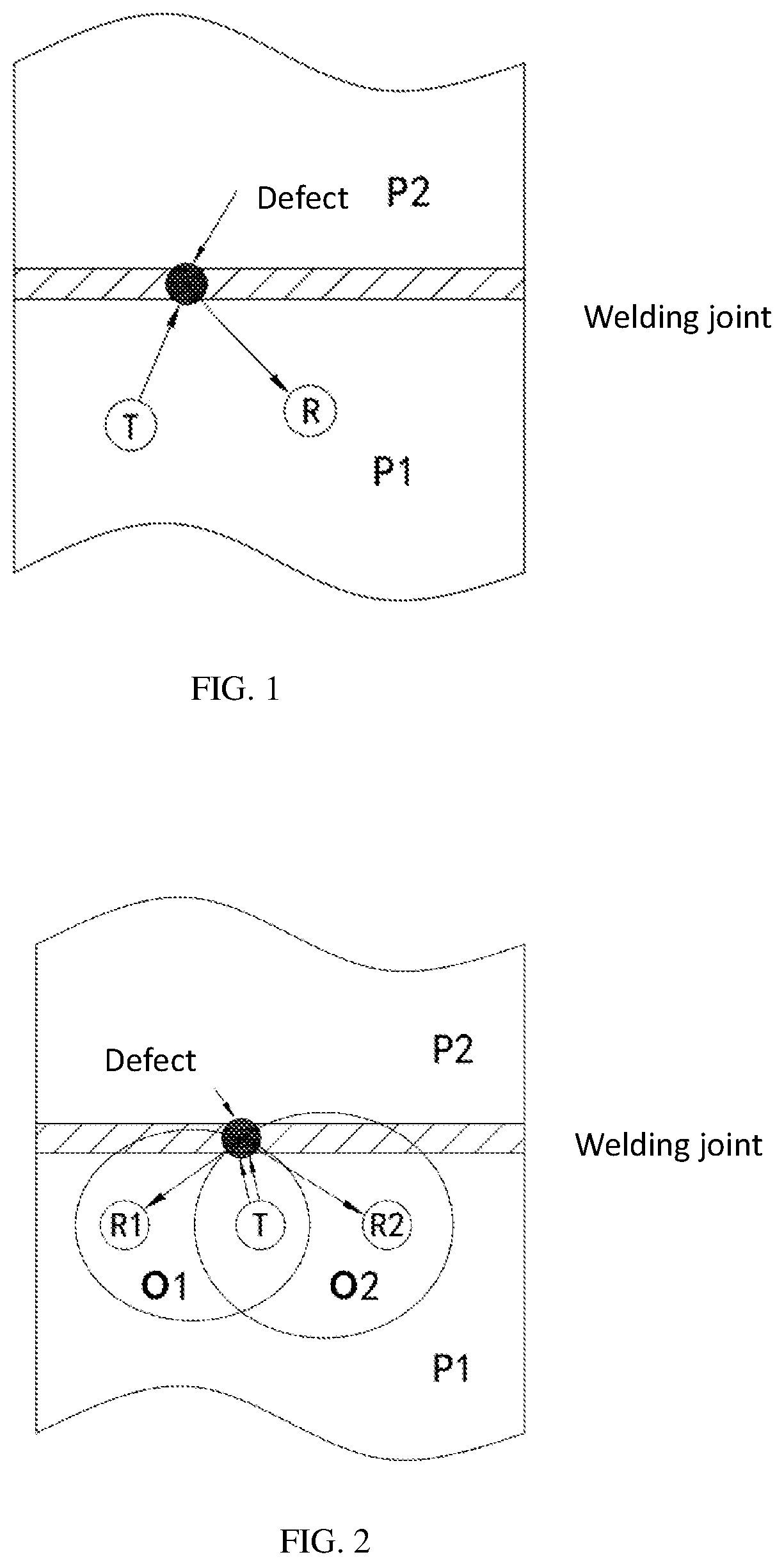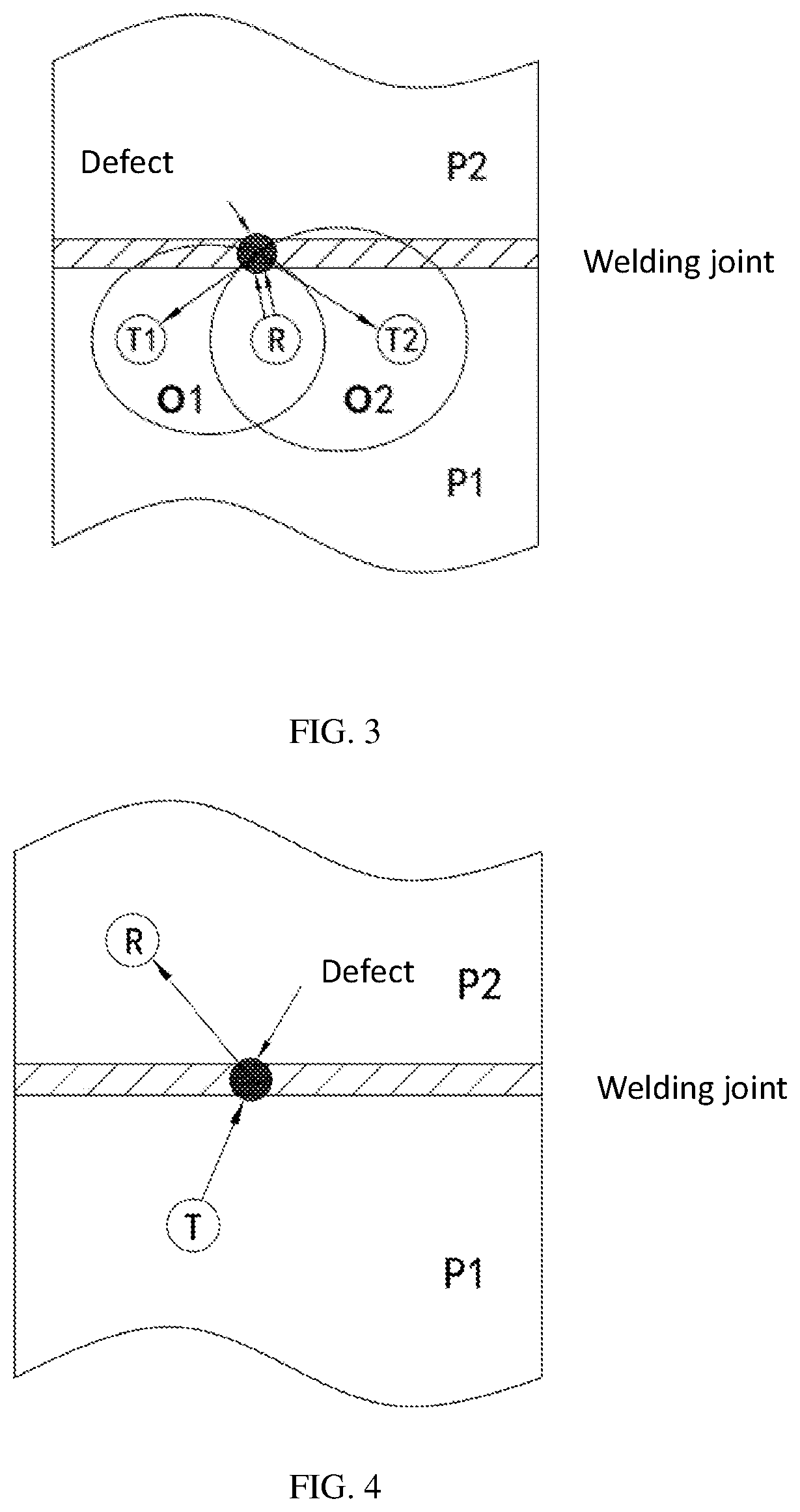Apparatus and method for monitoring of welding joints with in-situ sensors
a technology of in-situ sensors and apparatus, applied in the field of welding technology, can solve the problems of large economic losses, catastrophic consequences, and failure of welded structures, and achieve the effect of preventing disaster accidents and optimizing maintenance efficiency
- Summary
- Abstract
- Description
- Claims
- Application Information
AI Technical Summary
Benefits of technology
Problems solved by technology
Method used
Image
Examples
embodiment 1
[0038]In embodiment 1, the apparatus for scheduled, real-time, or on-demand monitoring of welding joints includes an ultrasonic actuator T, an ultrasonic receiver R, a signal processing unit, and a control unit. The signal processing unit can be a single chip microcomputer, and the control unit can be an FPGA, a DSP chip or a single chip microcomputer. The signal processing unit can also be integrated with the control unit on a single chip microcomputer or FPGA. The control unit may generate a schedule or on-demand command for monitoring welding joints.
[0039]In FIG. 1, T is an ultrasonic actuator, R is an ultrasonic receiver, and P1 and P2 are two structures welded together through a butt joint. Actuator T and receiver R are mounted on structure P1.
[0040]The following is the working principle of the apparatus for scheduled, real-time, or on-demand monitoring of welding joints provided by the embodiment. The control unit controls the actuator T to emit ultrasonic signals. Some ultras...
embodiment 2
[0044]In embodiment 2, the apparatus for scheduled, real-time, or on-demand monitoring of welding joints includes an actuator T, a first receiver R1, a second receiver R2, a signal processing unit and a control unit. The signal processing unit can be a single chip microcomputer. The control unit can be an FPGA, a DSP chip or a single chip microcomputer. The signal processing unit can also be integrated with the control unit on a single chip microcomputer or FPGA.
[0045]In FIG. 2, T is an ultrasonic actuator, R1 is a first ultrasonic receiver, R2 is a second ultrasonic receiver, and P1 and P2 are two structures welded together through a butt joint. Actuator T, receiver R1, and receiver R2 are mounted on structure P1.
[0046]The following is the working principle of the apparatus for scheduled, real-time, or on-demand monitoring of welding joints provided by the embodiment. The control unit controls actuator T to emit ultrasonic signals. Some ultrasonic signals are reflected from the wel...
embodiment 3
[0052]In embodiment 3, the apparatus for scheduled, real-time, or on-demand monitoring of welding joints includes a first ultrasonic actuator T1, a second ultrasonic actuator T2, an ultrasonic receiver R, a signal processing unit and a control unit. The signal processing unit can be a single chip microcomputer. The control unit can be an FPGA, a DSP chip or a single chip microcomputer. The signal processing unit can also be integrated with the control unit on a single chip microcomputer or FPGA.
[0053]In FIG. 3, T1 is a first ultrasonic actuator, T2 is a second ultrasonic actuator, R is an ultrasonic receiver, and P1 and P2 are two structures welded together through a butt joint. Actuator T1, actuator T2, and receiver R are mounted on structure P1.
[0054]The following is the working principle of the apparatus for scheduled, real-time, or on-demand monitoring of welding joints provided by this embodiment. The control unit controls actuator T1 and actuator T2 to emit ultrasonic signals....
PUM
| Property | Measurement | Unit |
|---|---|---|
| distance | aaaaa | aaaaa |
| temperature | aaaaa | aaaaa |
| size | aaaaa | aaaaa |
Abstract
Description
Claims
Application Information
 Login to View More
Login to View More - R&D
- Intellectual Property
- Life Sciences
- Materials
- Tech Scout
- Unparalleled Data Quality
- Higher Quality Content
- 60% Fewer Hallucinations
Browse by: Latest US Patents, China's latest patents, Technical Efficacy Thesaurus, Application Domain, Technology Topic, Popular Technical Reports.
© 2025 PatSnap. All rights reserved.Legal|Privacy policy|Modern Slavery Act Transparency Statement|Sitemap|About US| Contact US: help@patsnap.com



